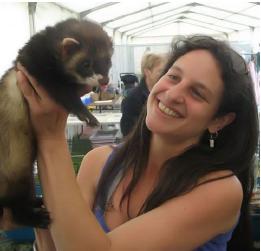The European Polecat (Mustela putorius)
by Paul Pountain
At the turn of the century our native European polecat was living in abundance, but come the mid 1930's their numbers experienced a severe decline due to persecution by both landowners and gamekeepers alike to such an extent that they nearly became extinct on these shores. It was once reported that there were less than fifty polecats remaining throughout England, Scotland and Wales. One of the most probable reasons for this drastic reduction in numbers was the introduction of certain pesticides and rodenticides plus the very likely case of mistaken identity: being taken for one of its close cousins in the mustelid family, the mink.
Fortunately, recent years have been more kind to the polecat with both farmers and landowners better understanding their habitats. In fact, farmers are becoming more tolerant of creatures like the polecat and the stoat due to their hunting habits that help reduce the increasing numbers of rabbits and rats which affect the majority of all crop farmers as well as infesting grain stores. Another aid to its recovery was the introduction in 1981 of the Countryside & Wildlife Act which was passed through parliament as a law to help protect certain species of birds and animals native to our shores. Section 6 of this act was to place a conservation order on a number of different birds, animals and mammals including the polecat. Since then polecat numbers and sightings have steadily increased over the years and from its once main stronghold in Wales, it is now beginning to venture eastwards into mainland England with its habitat now reaching Herefordshire, Gloucestershire, Oxfordshire, Wiltshire, Hampshire and parts of Dorset. It has also been recorded in Shropshire and as far north as Cheshire.
Conservation groups such as the Vincent Wildlife Trust (VWT) and the British Mammal Society have also done their bit with regards to helping the polecat regain its old territories. Hundreds of volunteers have carried out surveys to establish where polecats are now thriving in our countryside. Two recent surveys conducted by the VWT, one in the 1990's and the other in 2006 bode well in mapping the whereabouts of these much disregarded and elusive creatures and show that the native population is steadily increasing and is thriving in many areas such as Wiltshire and parts of Hampshire. These findings show that many people are changing their attitudes towards the way we farm and look after our countryside. This can only help the polecat regain its claim to these shores.
So how do we recognize a polecat? Polecats are members of a family known as the Mustelidae which includes weasels, stoats, ferrets, mink, martens, otters and badgers. The polecat in appearance resembles its closest cousin, the ferret. In fact it is the ferret that has been derived from the polecat over many years of domestication through selective breeding. It is said that it was the Egyptians who domesticated the ferret thousands of years ago to primarily use as a tool for hunting.
There are two types of polecat of which the ferret is a close relation; the European polecat and the Steppe polecat. European polecats are very dark in colour, their coats vary from dark chestnut brown through to very nearly black. They have brown under-fur with dark guard hairs showing through which defines their darker colouration. On their face they have a dark banded mask covering their eyes and touching a dark nose. The ears have white tips to them and they also have a white muzzle and under-jaw. Polecats can also produce a rare throwback in their genes known as 'erythrism'. This makes their coat a red chestnut colour, whereas in ferrets the common 'throwback' is the albino colouration. The polecats' posture is much broader than that of ferrets with a larger head which is more visible in males. The true method of defining a polecat from a ferret is to measure what is called the 'post orbital width' of the skull. This is always wider in polecats.
The polecats' habitat is mainly that of low lying woodland areas and farmland. This is why their coat colouration is dark, so that they can blend into their natural surroundings.
 Whilst the Steppe polecat has similar markings to that of the European polecat it is much lighter in colour, touching light browns to beiges. Again, this is due to its natural habitat. The Steppe Plains of eastern Asia are dry arid grasslands bordering Russia, the exact opposite of our lush green farm and deciduous woodlands where our native polecat lives.
Whilst the Steppe polecat has similar markings to that of the European polecat it is much lighter in colour, touching light browns to beiges. Again, this is due to its natural habitat. The Steppe Plains of eastern Asia are dry arid grasslands bordering Russia, the exact opposite of our lush green farm and deciduous woodlands where our native polecat lives.
Polecats are mainly nocturnal creatures and as such are very elusive. Females may be seen during spring and early summer months hunting for food to feed their young: the main source of food being rabbits, mice, voles, ground-nesting birds, eggs and small invertebrates. Recent surveys show its numbers doing positively well where there is a plentiful supply of rabbits! The polecats' breeding season is very similar to that of the ferret, where longer daylight hours trigger their hormones, for this reason they are known as photoperiodic breeders. The male will mate with the female then leave her to rear the young. Again, the gestation period of polecats is very close to that of the ferret; approximately 42 to 44 days when as many as up to five kits can be born in a litter. Polecats can breed up to two times in any one year.
For more information on the polecat, please contact either the Vincent Wildlife Trust or the British Mammal Society.
